Human Tongue Parts, Functions With Details And Diagram
Like fingerprints, your tongue has a unique print pattern and it’s home to 5000 taste buds! How do different tongue parts help you taste, touch, smell, and swallow food? By the time you turn 20, you may lose half your taste receptors!
You’ve 5 senses and 5 basic tastes – the 5th one is the Glu-related Asian food taste.A very special and fantastic tool, the tongue is also used to select food, suck, lick, masticate, chew, say words, catch prey, clean eyes and fur, and so on. And different parts of the tongue play a critical role in respiration too.
On the surface, you can distinguish into the anterior and posterior parts. A side view makes visible 3 divisions, i.e.
10 Human Tongue Parts
- The Tip or Apex :This highly agile part houses taste buds for sweet.
- The Body or Main Part :The body contains buds for salty, bitter, and sour tastes.
- The Root or Base :It attaches the tongue to the floor of the mouth cavity.
- Tunica Mucosa :Housing taste buds, it also serves abrasive function during mastication.
- Aponeurosis Linguae :It provides a surface for the attachment of the lingual muscles.
- Muscular Layer :3D skeletal muscles render extreme mobility to the tongue.
- Lingual Papillae :6 Types of lingual papillae form lingual mucosa on the back of the tongue.
- Septum of the Tongue :The fibrous septum divides the tongue into two symmetrical halves.
- Lingual Arteries :The sublingual artery rapidly responds to temperature changes.
- Lingual Veins :They include the dorsal, deep and the sublingual veins.
While learning the 10 human tongue parts in detail, you’ll also come across various tongue functions, its diagram, and diseases.
Did you know?The modern research rejects the traditional belief that different parts of the tongue are specialized to only recognize a specific taste.
Read on to discover enticing facts about the human tongue parts and functions.
Here you will also get answers to the questions like:
- How does the tongue help you gauge a person’s health?
- What is the 5th basic taste called?
- >How long is the human tongue?
- Which type of papilla may house up to 1600 taste buds?
Tongue Definition:
You can define the tongue in several ways.
For example, The Free Online Dictionary defines it as:
A small, fleshy and muscular organ attached to the floor of your mouth that helps in tasting, chewing, swallowing and speaking is called the tongue.
According to Oxford Learners (OALD) Dictionaries:
“Tongue is the soft part in your mouth that you move around and use it for taste, swallowing, and speaking, etc.”
Here is another tongue definition by Webster’s Dictionary.
“A fleshy, movable muscular organ in the floor of the mouth of most vertebrates that contains sensory organs and small glands and functions in taking and swallowing food, and also as a speech organ in humans.”
Considering the value of the human tongue, this small muscular organ in your mouth cavity is a wonderful blessing of nature.
In addition to providing a taste of the food, the tongue helps in the manipulation of food for mastication.
Its third important job is to help in the swallowing of a meal.
How Long is the Human Tongue?
On average, a human tongue is three to four inches long.
Robin Kerrod (1997) in ‘The MacMillan Encyclopedia of Science’ claims that an average length of the human tongue is 10 cm.
Did you know?Human females have a smaller and a lighter tongue.
Its average weight in human males is about 70g and in females 60g.
An obese person is likely to have a fatter tongue.
It may lead to health problems like obstructive sleep apnea (OSA).
In this condition, the airways get blocked, so the victim may stop breathing while they’re asleep.
Tongue Anatomy:
Occupying most of the oral cavity and oropharynx, your tongue is a mass of muscles.
The specific arrangement of muscle fibers allows it to move freely in any direction inside the mouth cavity.
Owing to its high mobility, the tongue can perform several different tasks.
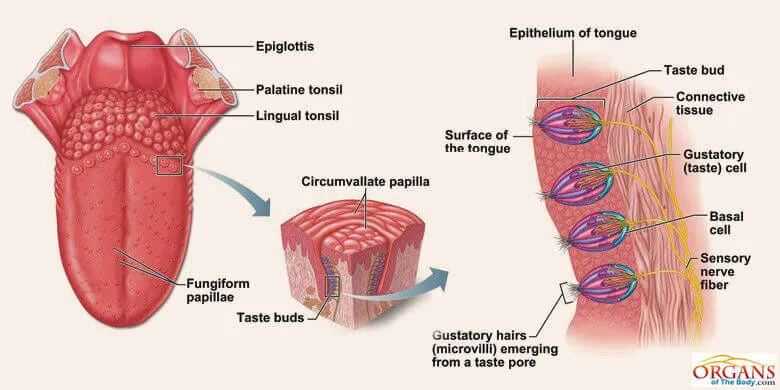
Fig. 2: Tongue Anatomy
Anatomically, you can distinguish between three tongue parts.
The tip is highly mobile, anterior portion.
Posterior to it lies the body which has ventral and dorsal surfaces.
Next comes the base which attaches the tongue to the floor of the mouth.
The major aspects of tongue anatomy are being explained below:
Lingual Papillae on the Surface:
Where does the tongue get its characteristic appearance?
The lingual papillae on the surface of the organ are small bumps that contain taste buds.
These bumps are the projections of lamina propria and are covered with tongue epithelium.
Types of Papillae:Filiform, foliate, vallate and fungiform are four of the six different types of papillae found on the surface.
Different papillae contain a different number of taste buds.
For example, a vallate papilla may contain 250 taste buds, while the number of taste buds may reach 1600 in the fungiform papilla.
A taste receptor, edge, and basal cells are found in each taste bud.
Meanwhile, several nerve fibers innervate each one.
Tongue Muscles:
The musculature of the tongue consists of four extrinsic and four intrinsic muscles. A fibrous septum separates the tongue muscles on each side.
The intrinsic muscles originate from within the tongue body.
On the other hand, extrinsic muscles have their origin outside the body of the organ. [8]
Both types of muscles work in coordination to create various tongue movements.
However, each has a specific role as well.
For example, the extrinsic muscles change the position of the tongue, while the intrinsic fibers alter its shape.
Tongue Nerve Supply and Vasculature:
The arterial blood supply for the tongue comes from the external carotid artery.
It branches off to join the lingual artery which has three main branches.
They are the dorsal, the deep, and the sublingual arteries.
The branches of the lingual artery supply blood to different parts of the tongue.
Turning to tongue nerve supply, the hypoglossal nerve provides most innervation for all the tongue muscles.
Tongue Surface:
What are the tongue bumps?
As you can observe in the tongue pictures, the human tongue has got a rough texture.
It is because of the presence of tiny bumps, the tongue papillae, all over the dorsal surface of the tongue that the organ looks so rough.
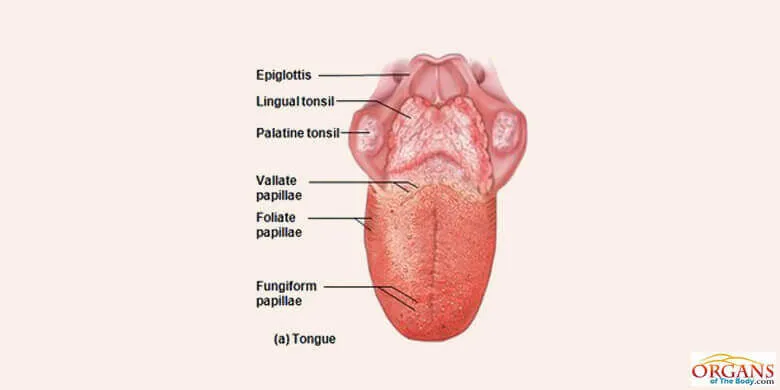
Fig. 3: Tongue Surface
The surfaces of the tongue papillae, on the other hand, contain thousands of taste buds.
The taste buds are a collection of the nerve-like cells.
Nerves develop a connection between taste buds and the brain.
You can call them a communications network.
The uppermost layer of tissue on the human tongue is that of the mucosa.
The mucosa keeps it moist.
It also makes the tongue a bit slippery to touch.
Tongue Function:
A very strong and highly agile muscle in the mouth cavity, your tongue functions in multiple capacities.
While you know it as an organ of taste, it does make big contributions to speech production, digestion, and diagnosis of different diseases.
Did you ever think?Without the tongue, you would have been unable to taste all the deliciousness of the natural and artificial world.
Can the scientists create and install such a tool in your body that would enable you to taste things in the absence of the tongue?
Maybe the invention of such an instrument is possible, but it can never work as perfectly as your natural human tongue.
You spend so much money to make the food delicious.
How do you taste the delicacy of the food you consume?
You owe this faculty to your tongue.
In addition to detecting taste, the human tongue also performs several other important functions.
For example, the tongue function also involves the mastication of food, catching prey, licking, sucking, and swallowing.
Do you know any other interesting tongue function?
The list of some of the important tongue functions is given below:
Tongue – A Tool to Taste Food:
The ability of the tongue to taste the food is because of the presence of taste buds on its surface.
According to a traditional belief, different parts of the tongue are specialized to only sense a specific taste.
Did you know?The modern research rejects this belief.
It suggests that different parts of the tongue detect a specific taste more easily (and strongly).
But they can detect other tastes as well.
However, each receptor cell is sensitive to a specific taste only.
Different types of receptor cells help distinguish between various sorts of differently tasting substances.
They may taste sweet, sour, bitter, spicy, and salty.
As already discussed, you will find taste buds for sensing something sweet.
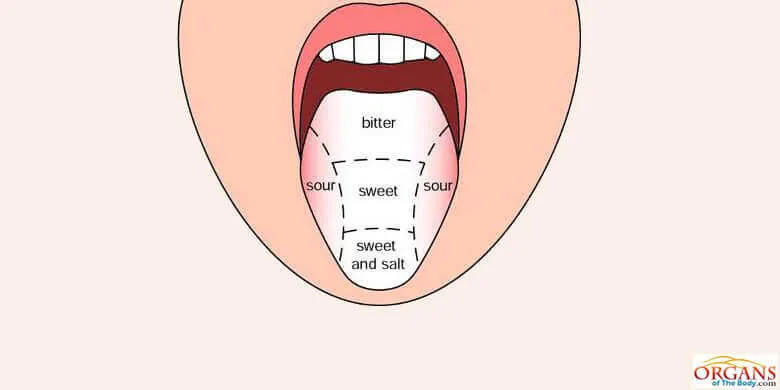
Fig. 4: A Tool to Taste Food
Behind the apex and along the sides, there are receptors for tasting bitter, sour and salty things.
Dorsum – the upper surface of the tongue – contains lots of lingual papillae. The papillae house the buds and receptors for the sense of taste.
These receptors assist in the sensation of the taste of different types of dietary components.
It happens when food comes into contact with the receptor cells.
The taste receptors are of five main types – sweet, bitter, salty, sour, and umami taste receptors.
The umami taste receptors help you detect the taste of amino acids in your diet.
Here umami or savory is the 5th basic taste you can sense with the help of the tongue.
Human Tongue’s Role in Mastication & Chewing:
After the food enters the mouth cavity, two processes start and go side by side. They are grinding and mastication.
During grinding, teeth break down the large food particles into smaller ones.
Thus, there is an easy mixing of these particles with saliva to form a bolus.
Mastication involves the mixing of finely ground food with saliva.
That is why you also call the process as chewing.
Tongue facilitates the process of mastication and chewing.
Particularly, it helps in the positioning of food between the teeth.
Secondly, as the food turns around, it is mixed with saliva.
The masticatory muscles provide the enormous strength of jaw closure.
It is due in large part to the pinnate arrangement of fibers in the masseter.
The masseter is the masticatory muscle of the posterior cheek.
Removal of Hard and Ill-Tasting Substances:
How do you take hard and unwanted substances out that accidentally enter the mouth with food?
The tongue also has a role in separating, sorting out, and removing unsuitable particles that may accidentally come with the food.
They include bones and ill-tasting soft or hard substances.
Swallowing Food:
The masticated food forms a rounded mass or the bolus with the help of the tongue.
The task of this fantastic muscular organ does not end here.
Its next duty is to expel the bolus into the esophagus or food pipe at the back of the mouth cavity.
The food bolus then moves through the esophagus with the help of peristaltic contractions and enters the stomach.
Just imagine, how difficult it would have been for you to chew and engulf the food in the absence of tongue.
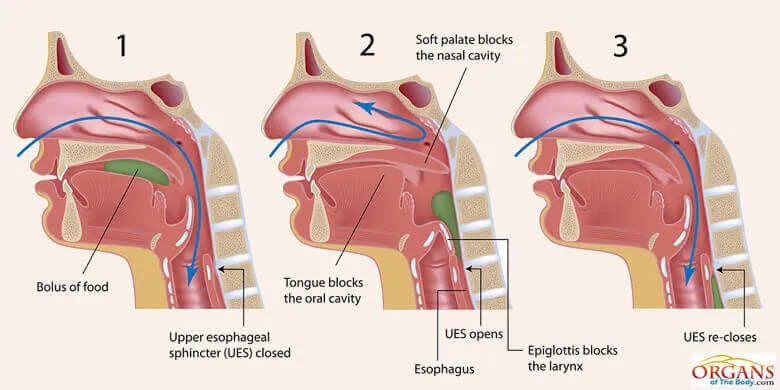
Fig. 5: Swallowing Food
Tongue as an Organ of Speech:
You produce different speech sounds when a stream of air coming from the lungs leaves the body through the mouth.
Your mouth cavity is home to various organs of speech.
Different speech organs include the tongue, teeth, lips, palate, and uvula, etc. Here, the tongue is of incredible importance.
The tip of the tongue, the body, and the back all significantly contribute to the production of vowels and other sounds.
You can only realize the true value of this major speech organ when it is not there.
Different parts of the tongue play their part in producing and modifying sounds.
For example, labiodental sounds are produced while the tip of the tongue touches the upper teeth.
To produce the /k/ and /g/ sounds, the back of the tongue raises against the rooftop or the palate.
Composed of a set of extremely movable muscles, the tongue can quickly assume various shapes.
This movement is vital for the efficient performance of all the assigned tasks.
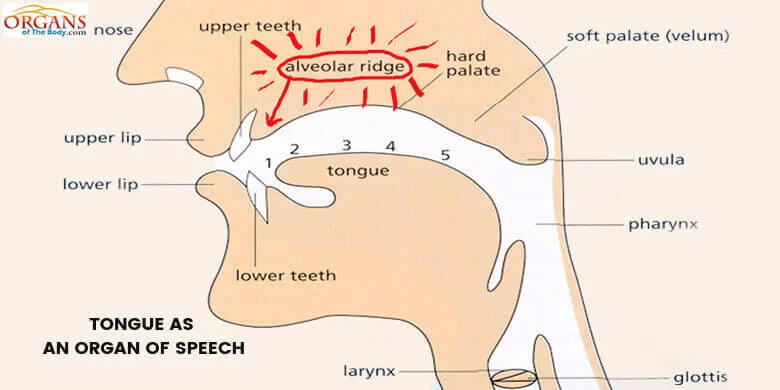
Fig. 6: Organ of Speech
An Organ for Sucking:
Almost all the mammals suck milk from the breasts of their mother-parent in infancy.
How are they able to suck milk? They do so with the help of their tongue.
It is done by creating a negative pressure within their oral cavity.

Fig. 7: Organ for Sucking
Indicator of Health:
Among different tongue facts, it is interesting to note that the tongue can tell you about a disease.
That is, its appearance serves as an indicator of health.
It takes time for the tongue to change its appearance. Therefore, the color of the tongue at a given time reflects the health of the individual.
For example, the appearance of a thicker white coat on the surface is the sign of predominance of cold in your body.
It represents a weakness in some physiological function or a viral infection.
The individuals with thick, yellow coating on the tongue are likely to have some bacterial infection or inflammation.
What should be the color of the tongue to indicate perfect health?
When the tongue color is pale-red, it means there is good circulation of blood in the body and you are enjoying good health.
As the color changes to nearly white or extremely pale, there should be something rotten in the state of Denmark.
So, you should consult your healthcare provider to diagnose the disease you might be suffering from.
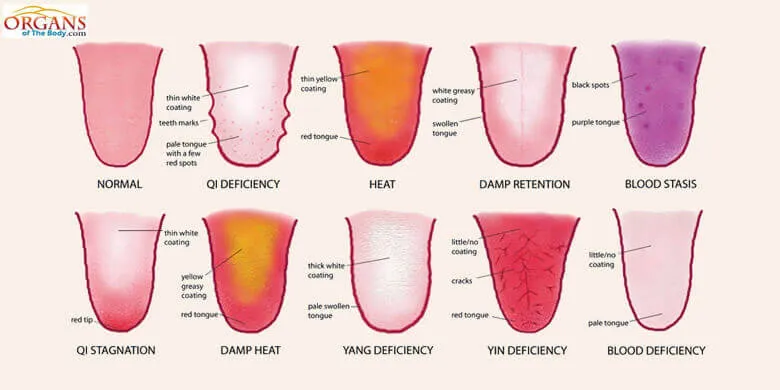
Fig. 8: Indicator of Health
Human Tongue Diseases:
The organ of taste is susceptible to various tongue conditions, including the infection, pain, swelling, and tongue sores.
Severe tongue diseases include cancer, ulcer, tongue blisters, and hemangioma.
Different tongue problems are likely to cause changes in taste.
Also, there may occur changes in color and texture.
Sometimes, the variations in the color and texture are also indicative of different diseases in other parts of the human body.
Tongue Cancer:
Tongue cancer is the most serious disorder that mostly affects people over 40.
The cancer forms in the squamous cells in the front two-thirds of your tongue (the oral tongue).
Covering the surface of your tongue, the squamous cells are thin, flat cells.
If malignancy appears in the back of your tongue (the base), it would be a kind of neck or head cancer.
Tongue biopsy helps diagnose the type and stage of the tumor.
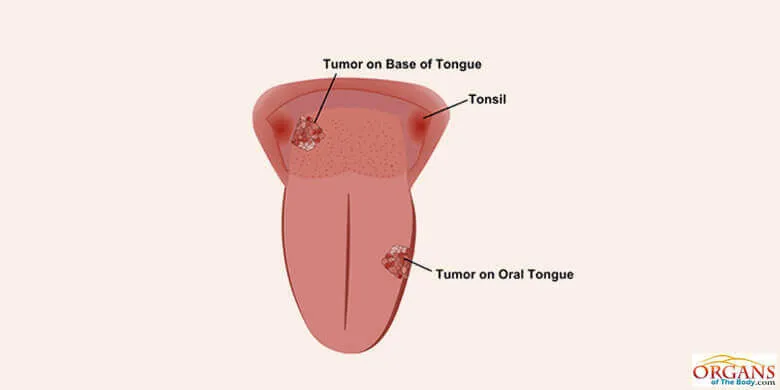
Fig. 9: Tongue Cancer
Symptoms:- Pain in the tongue or jaw that won’t go away.
- Tongue white patch/es, occasionally spreading to gums, tonsils, and lining of the mouth.
- Chewing and swallowing food may cause pain.
- Persistent mouth and tongue numbness.
- Bleeding from your tongue due to unexplained reasons.
- Sore throat and development of lump inside the mouth cavity.
Tongue cancer is a type of mouth or oropharyngeal cancer.
The exact causes of most head, neck, and mouth cancer are not known.
However, medical researchers have listed some risk factors for tongue cancer.
These risk factors include consumption of alcohol, smoking tobacco, and transmission of HPV virus through sexual contact.
Treatment:It will be easy to control and cure cancer if you detect and diagnose it in the early stages of development.
The suggestion of an effective treatment method for tongue cancer usually depends on its size.
Its spread to other parts of mouth like lymph nodes, tonsils, and gums is also considered.
Surgery, radiotherapy, and chemotherapy are advanced treatments for tongue cancer.
Meanwhile, the tongue cancer treatment plan may also include target drug therapy.
This therapy aims to stop the cell growth of targeted cancerous cells.
Sometimes, targeted drug therapy is used in combination with radiation or chemotherapy or both.
Tongue Ulcer:
The breakage or erosion of the surface of the tongue leads to the development of tongue ulcers.
The open tongue sores, associated with tongue ulcers, can appear in other parts of the mouth as well.
On the other hand, holes or breaks in the protective lining of the small intestine are called peptic ulcers.
Fortunately, the tongue ulcers are not that much harmful.
Nevertheless, they are still unpleasant at best and you need to take care of them.
Symptoms:The tongue ulcer symptoms are easily observable with the naked eye.
- The appearance of round or oval sores on the surface of the tongue.
- Sores may also appear on the gums, soft palate, lips, or along the sides of tongue and cheek.
- Experiencing tongue burn or a tingling sensation in the ulcerated area.
- Food, toothbrush, and braces may cause severe pain and irritation.
- A bad or reduced sense of taste.
Several different factors may lead to the appearance of painful tongue sores.
Physical injury, allergies, chemical sensitivity, food sensitivities, and bacterial or viral tongue infection are some of the common causes of mouth and tongue ulcers.
Other tongue ulcer causes include tongue fungus and immune disorders.
Here it is pertinent to note that even minor injuries, such as over-eager brushing, biting your tongue, sporting accidents, and dental works can cause ulcers.
Treatment:It isn’t that difficult to get rid of tongue ulcers.
The condition is rarely a cause for serious concern.
However, if you leave it unaddressed, the ulcers are likely to become more dangerous.
You can cure the disorder using some natural remedies.
For example, you can try using a saltwater or baking soda rinse to keep the would clean.
Secondly, you can make a paste of salt, baking soda, and milk of magnesia to soothe the area.
To ease swelling and inflammation, you can use mouthwash or rinse products that contain steroids.
If the natural remedies for tongue ulcers do not work, you need to consult your healthcare provider for tongue ulcer treatment.
Glossitis of the Tongue:
The benign migratory glossitis or simply the tongue glossitis is a painful condition of the tongue.
It refers to the loss of lingual papilla (depapillation) and smoothening and reddening of the surface of the organ.
Glossitis is a type of the geographic tongue.
In the geographic tongue, the irregular patches on the tongue give it a map-like appearance.
Papillae, the small bumps on the surface of your tongue, contain thousands of tiny sensors or taste buds.
They help you detect the taste of different types of foods you eat.
When the lingual papillae disappear due to glossitis, you experience a bad or reduced taste of the delicious things you eat.
At the same time, you may also face difficulty in speaking, eating and swallowing. [16]
There are different types of glossitis, including acute, chronic, atrophic, and idiopathic.
In the case of acute glossitis, the inflammation of the tongue appears suddenly with severe symptoms.
Inflammation continues to recur in chronic glossitis which may be the result of some other health condition/s.
When your tongue loses many papillae with the change in its color and texture, you call the condition atrophic glossitis. It turns the organ dark red.
The idiopathic or Hunter’s glossitis, on the other hand, affects the tongue muscles and results in the loss of a significant number of papillae.
Symptoms:The symptoms of this condition include:
- Difficulty eating, speaking, and swallowing food.
- Feeling of tenderness and pain in the tongue.
- Inflammation and change in the color of your tongue.
- Disappearance or loss of lingual papillae.
- Smooth and reddened surface.
- Blocked airway (rare).
The causes of glossitis include allergic reactions to food, chemicals or medicines.
Bacteria, tongue virus or tongue yeast infection, and injury from burns or bad-fitting dentures may lead to depapilllation and redness of tongue.
Alcohol consumption, tobacco, spices, certain vitamin deficiencies, and hormonal factors may also contribute to the onset of the disease.
Meanwhile, the skin conditions that affect the mouth may also cause glossitis.
Treatment:Effective home remedies are available for the tongue glossitis treatment.
You can improve the health of your tongue, teeth, and gums by flossing and brushing your teeth several times a day.
In this way, you can not only relieve the symptoms of the condition but also prevent it from reoccurring.
If the home remedies alone do not work, you can go for a combination of medications and home care.
The medications will help fight bacterial or other infections.
Your doctor may prescribe the use of corticosteroids to reduce the soreness and redness.
Interesting Tongue Facts:
- The cats like tiger, lion, cheetah, and house cat can’t taste sweets.
Reason: The cat’s sweet perception genes are broken. (The pseudo or broken gene in cats makes them unable to detect sweet taste.) - The tongue taste buds are specialized to detect five different types of tastes, namely, sweet, sour, salty, bitter, and umami.
- Umami is the representation of the taste of amino acids.
- Why does toothpaste affect the taste of certain foods?
Reason: It contains four main ingredients, viz. water, abrasives, fluoride, and detergents (usually sodium lauryl sulfate or SLS). SLS suppresses sweet receptors. - Your tongue may contain 2,000 to 8,000 taste buds.
- Taste buds are small organs, embedded in the tongue epithelium, that function in the perception of taste.
- A muscular organ, your tongue does not contain a bone or cartilage and is capable of various muscular movements.
- Some mammals, like cats, use their tongue for cleaning and grooming!
- The animals, like frogs, have an elongated tongue that is adapted to capturing insect prey.


